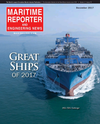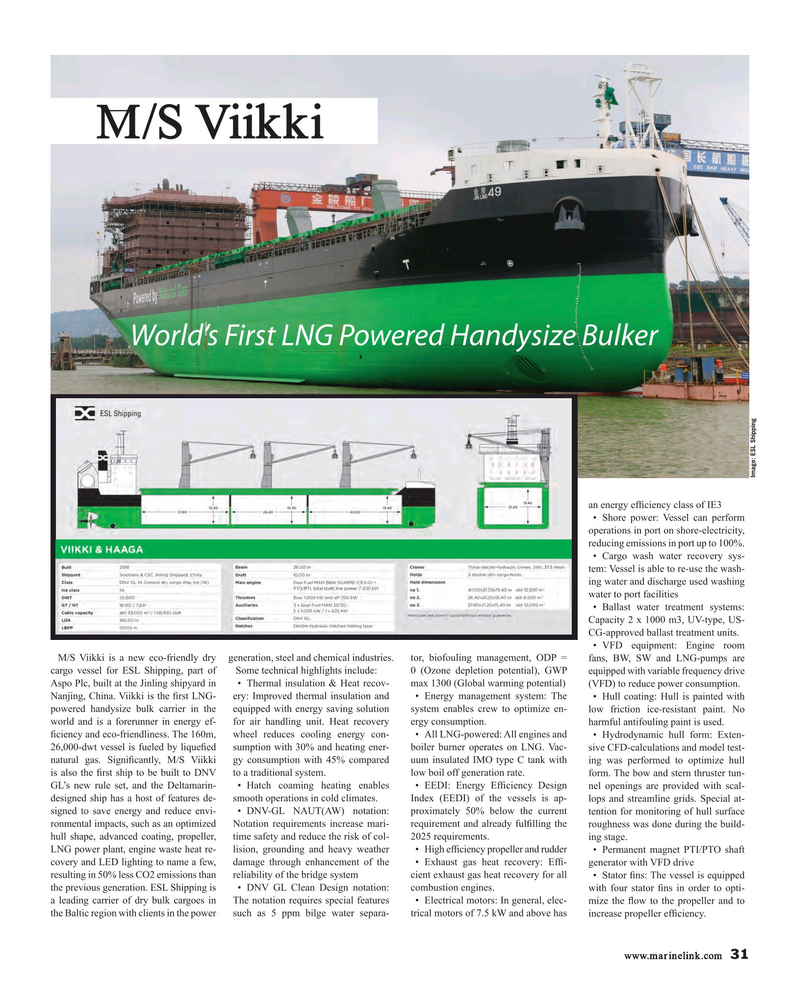
Page 31: of Maritime Reporter Magazine (December 2017)
U.S. Navy Quarterly
Read this page in Pdf, Flash or Html5 edition of December 2017 Maritime Reporter Magazine
M/S Viikki
World’s First LNG Powered Handysize Bulker
Image: ESL Shipping an energy ef? ciency class of IE3 • Shore power: Vessel can perform operations in port on shore-electricity, reducing emissions in port up to 100%.
• Cargo wash water recovery sys- tem: Vessel is able to re-use the wash- ing water and discharge used washing water to port facilities • Ballast water treatment systems:
Capacity 2 x 1000 m3, UV-type, US-
CG-approved ballast treatment units.
• VFD equipment: Engine room
M/S Viikki is a new eco-friendly dry generation, steel and chemical industries. tor, biofouling management, ODP = fans, BW, SW and LNG-pumps are cargo vessel for ESL Shipping, part of Some technical highlights include: 0 (Ozone depletion potential), GWP equipped with variable frequency drive
Aspo Plc, built at the Jinling shipyard in • Thermal insulation & Heat recov- max 1300 (Global warming potential) (VFD) to reduce power consumption.
Nanjing, China. Viikki is the ? rst LNG- ery: Improved thermal insulation and • Energy management system: The • Hull coating: Hull is painted with powered handysize bulk carrier in the equipped with energy saving solution system enables crew to optimize en- low friction ice-resistant paint. No world and is a forerunner in energy ef- for air handling unit. Heat recovery ergy consumption. harmful antifouling paint is used. ? ciency and eco-friendliness. The 160m, wheel reduces cooling energy con- • All LNG-powered: All engines and • Hydrodynamic hull form: Exten- 26,000-dwt vessel is fueled by lique? ed sumption with 30% and heating ener- boiler burner operates on LNG. Vac- sive CFD-calculations and model test- natural gas. Signi? cantly, M/S Viikki gy consumption with 45% compared uum insulated IMO type C tank with ing was performed to optimize hull is also the ? rst ship to be built to DNV to a traditional system. low boil off generation rate. form. The bow and stern thruster tun-
GL’s new rule set, and the Deltamarin- • Hatch coaming heating enables • EEDI: Energy Ef? ciency Design nel openings are provided with scal- designed ship has a host of features de- smooth operations in cold climates. Index (EEDI) of the vessels is ap- lops and streamline grids. Special at- signed to save energy and reduce envi- • DNV-GL NAUT(AW) notation: proximately 50% below the current tention for monitoring of hull surface ronmental impacts, such as an optimized Notation requirements increase mari- requirement and already ful? lling the roughness was done during the build- hull shape, advanced coating, propeller, time safety and reduce the risk of col- 2025 requirements. ing stage.
LNG power plant, engine waste heat re- lision, grounding and heavy weather • High ef? ciency propeller and rudder • Permanent magnet PTI/PTO shaft covery and LED lighting to name a few, damage through enhancement of the • Exhaust gas heat recovery: Ef? - generator with VFD drive resulting in 50% less CO2 emissions than reliability of the bridge system cient exhaust gas heat recovery for all • Stator ? ns: The vessel is equipped the previous generation. ESL Shipping is • DNV GL Clean Design notation: combustion engines. with four stator ? ns in order to opti- a leading carrier of dry bulk cargoes in The notation requires special features • Electrical motors: In general, elec- mize the ? ow to the propeller and to the Baltic region with clients in the power such as 5 ppm bilge water separa- trical motors of 7.5 kW and above has increase propeller ef? ciency.
www.marinelink.com 31
MR #12 (26-33).indd 31 MR #12 (26-33).indd 31 12/6/2017 12:14:00 PM12/6/2017 12:14:00 PM

 30
30

 32
32
